Artisan bread and sourdough are terms that often pop up side by side in the world of bakery craftsmanship. You may find yourself puzzled as you stand before a bakery shelf, debating whether to grab that crusty loaf of artisan bread or the tangy, chewy sourdough. Artisan bread encompasses a variety of loaves, each one a result of careful mixing, fermenting, and baking processes honed by bakers devoted to traditional methods. These breads are typically characterized by their quality ingredients, lack of preservatives, and the distinctive skills required to create them.
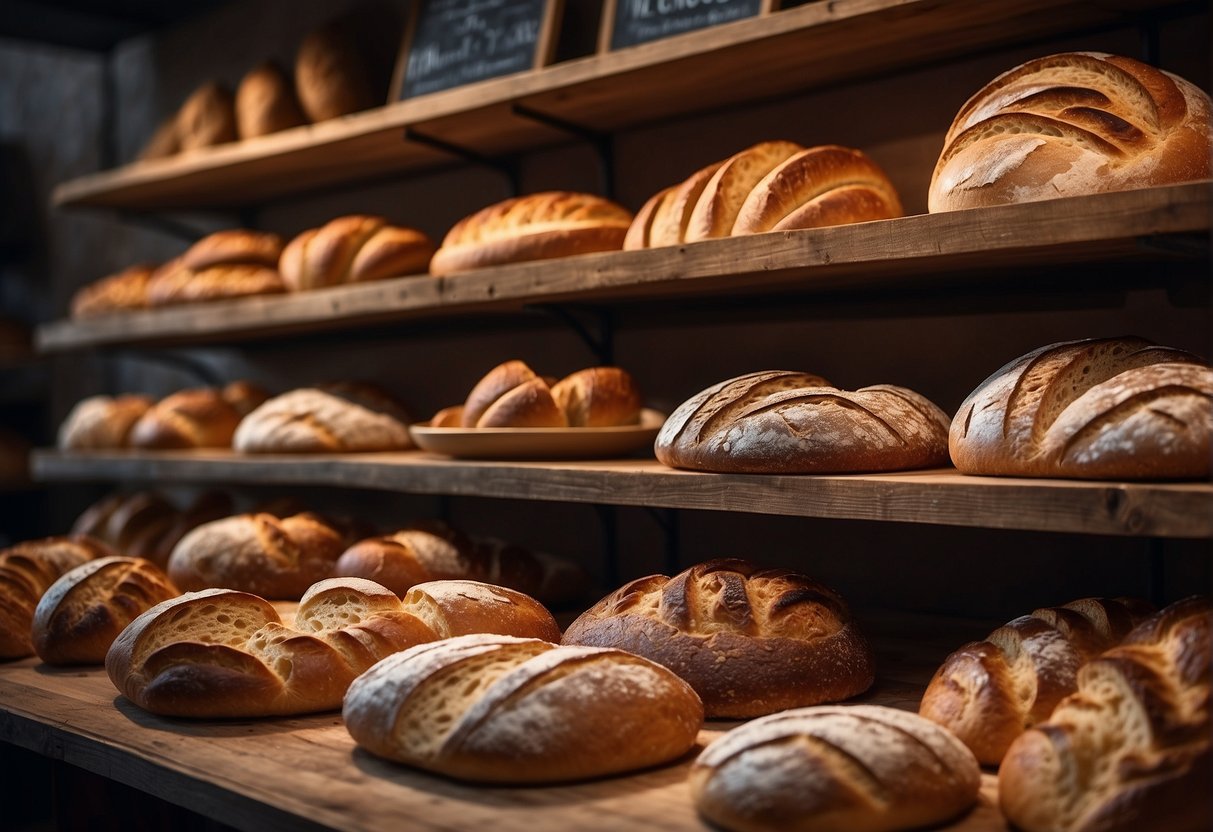
On the other hand, sourdough is a type of artisan bread that has a unique fermentation process powered by natural yeast and bacteria. This process not only imparts a characteristic sour taste but also results in benefits like improved digestibility and nutritional perks. When you choose sourdough, you’re embracing a bread with a deep history, dating back thousands of years—its enduring popularity standing testament to its distinct flavor and hearty texture. Comparing artisan bread to sourdough isn’t just about taste, it’s about understanding the subtleties and traditions that define the art of baking.
Understanding Artisan Bread
Artisan bread is about embracing tradition and emphasizing quality. With its roots in age-old practices, each loaf is a testament to the art of baking.
Key Ingredients and Their Roles
- Flour: The foundation of your artisan bread, providing structure. Select high-quality flour for the best results.
- Water: Water is critical for dough formation and affects the crumb or texture of the bread.
- Salt: Enhances flavor, regulates yeast activity, and strengthens the dough.
- Yeast: Can be commercial or wild, and it is responsible for the dough’s fermentation, which is key for texture and flavor.
By using these ingredients, your bread embodies the essence of what makes artisan bread special.
The Art of Hand-Kneading
Hand-kneading your artisan bread serves two purposes:
- It develops the gluten network crucial for a good crumb.
- It incorporates air, which is essential for proper fermentation.
Through this tactile process, the baker connects with the craft, ensuring a distinctive quality and texture.
Time-Honored Baking Techniques
- Slow Fermentation: This process allows flavors to develop fully and contributes to your bread’s texture.
- Steam Injection: Creates a crisp crust paired with a soft interior.
- Oven Spring: The final burst of rising that happens in the oven, contributing to the artisan bread’s rustic appearance.
By adhering to these techniques, your bread maintains the integrity and distinctiveness expected of artisanal products.
Exploring Sourdough Bread
Sourdough bread stands out with its unique flavor and texture, a result of its natural leaven, the sourdough starter, and the fermentation process.
Sourdough Starter: The Heart of Flavor
The sourdough starter is a mixture of flour and water inhabited by wild yeast and bacteria. Your starter is the cornerstone of your sourdough bread, giving it that characteristic tangy flavor. You’ll nurture it by feeding it regularly with fresh flour and water. With each feed, the wild yeast and bacteria convert sugars into carbon dioxide and organic acids, leading to the bread’s distinct flavor.
Fermentation Process and Its Effects
Fermentation is a crucial step in crafting sourdough bread. This period, during which the dough rests, can vary from several hours to days. As it ferments, the dough’s flavor and texture develop. A longer fermentation time allows for more complex flavors to emerge, as the natural yeasts and bacteria produce various byproducts:
- Organic acids: Create sourness
- Carbon dioxide: Contributes to the rise
- Alcohols: Add depth to the aroma
During this process, the gluten network also strengthens, contributing to a chewy texture in the final loaf.
Sourdough’s Distinctive Taste and Texture
Sourdough’s unmistakable taste and texture set it apart from other bread. The presence of lactic and acetic acid bacteria imparts a tangy flavor, often described as more complex than that of yeast-leavened bread. It’s this tanginess you’ll notice first when biting into a slice. Furthermore, the well-developed gluten network during fermentation gives sourdough a chewy and hearty texture. Your sensory experience is further enhanced by the bread’s crust, which, when properly baked, offers a satisfying crunch contrasting the soft interior.
Comparison of Artisan Bread and Sourdough
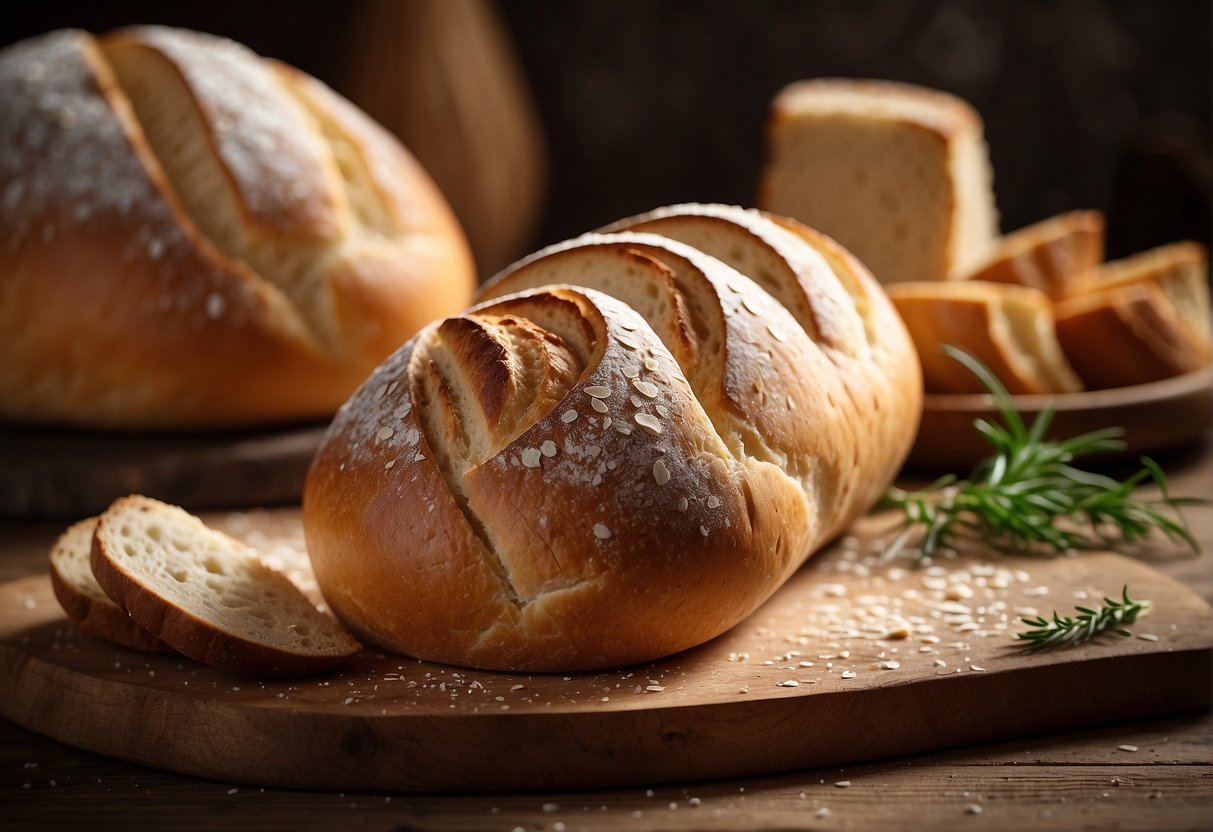
In comparing artisan bread and sourdough, you’ll find distinct variations in ingredients, taste, texture, and nutritional values. Each has unique characteristics that may influence your preference.
Ingredients and Leavening Agents
Artisan Bread generally refers to breads made by craft bakers with high-quality ingredients and by hand. The leavening agent in artisan bread is typically commercial yeast. This allows for a quicker rise and more control over the fermentation process.
Sourdough Bread, on the other hand, is made with a natural starter. This starter consists of flour and water, and it harnesses wild yeast and lactobacilli to ferment the dough. This method usually requires more time to rise than artisan bread due to the slower acting nature of natural yeast present in the starter.
Flavor Profiles and Textural Differences
The flavor of sourdough bread can range from mildly tangy to sharply sour, depending on the age of the starter and the length of the fermentation. Sourdough typically has a more complex flavor profile compared to many artisan breads. In terms of texture, sourdough often presents a crusty exterior with a chewy and dense interior.
On the other side, artisan bread can also have a crispy crust, but its interior is usually less dense and can be soft and airy. The flavor of artisan breads can be subtly nuanced and is often dictated by additional ingredients like seeds, nuts, or herbs.
Health Aspects and Nutrition Value
Sourdough bread might be considered healthier for some, as the fermentation process can reduce the phytic acid content, potentially allowing for better nutrient absorption. It also typically has a lower glycemic index, which can be beneficial for blood sugar management.
Artisan breads, with their diverse range of styles and ingredients, can also be nutritionally rich. They often have a high fiber content, especially when whole grains are used, though this can vary widely depending on the specific type of bread.
Both varieties of bread contain gluten, but sourdough bread has been reported to be easier to digest for some people due to the fermentation breaking down more gluten than in yeasted artisan bread. Always consult with a healthcare professional regarding specific dietary needs or concerns.
The Health Benefits of Different Breads
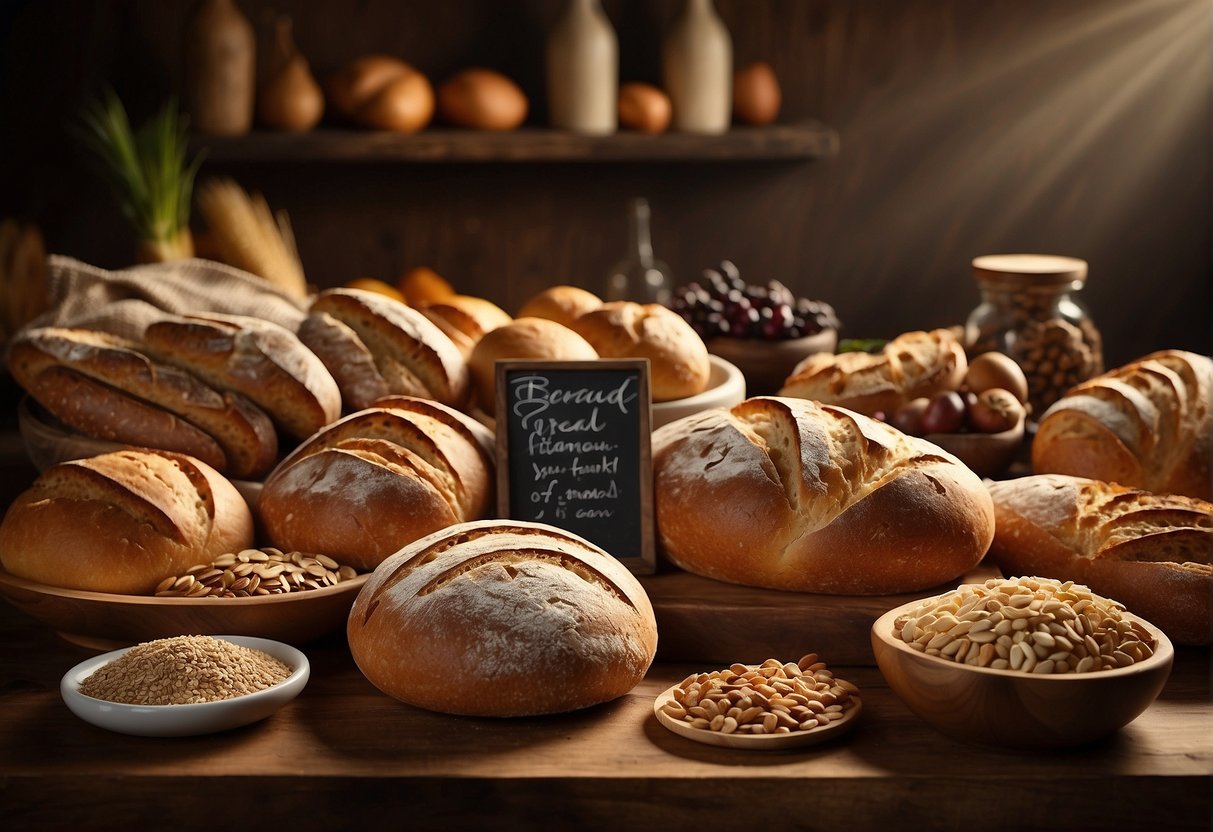
Artisan bread and sourdough offer distinct health advantages that cater to a variety of dietary needs. You’ll find they differ in nutritional makeup and how they affect digestion and blood sugar levels.
Nutritional Components and Digestibility
Artisan Bread:
Artisan bread, particularly when made with whole grains, is a good source of essential nutrients.
- Nutrients: Provides vitamins like B vitamins, minerals such as iron and magnesium, and a considerable amount of fiber.
- Digestibility: The presence of fiber contributes to a more digestible loaf, especially when the bread includes a mix of grains and seeds.
Sourdough Bread:
Sourdough’s unique fermentation process enhances its health benefits, often making it a preferable choice for those with sensitivities.
- Lactic Acid: Sourdough contains lactic acid, which lowers the bread’s phytic acid level, making nutrients more accessible.
- Digestion: The fermentation makes it easier to digest for some individuals, with reduced gluten sensitivities as a potential benefit.
Impact on Blood Sugar and Gluten Sensitivity
Glycemic Index:
The glycemic index (GI) measures how much a food raises your blood sugar.
- Artisan Bread:
- Whole grain options have a lower GI, beneficial for blood sugar control.
- Sourdough Bread:
- Typically has a lower GI, helping to moderate blood sugar spikes after meals.
Gluten Sensitivity and Content:
The way the bread is made affects gluten content and its impact on those with sensitivities.
- Artisan Bread:
- Your choice of flour impacts the gluten content. Whole grains can be more tolerable for some people.
- Sourdough Bread:
- Fermentation partially breaks down gluten, potentially making sourdough easier to tolerate for those with mild gluten sensitivities.
Choosing the Right Bread for You
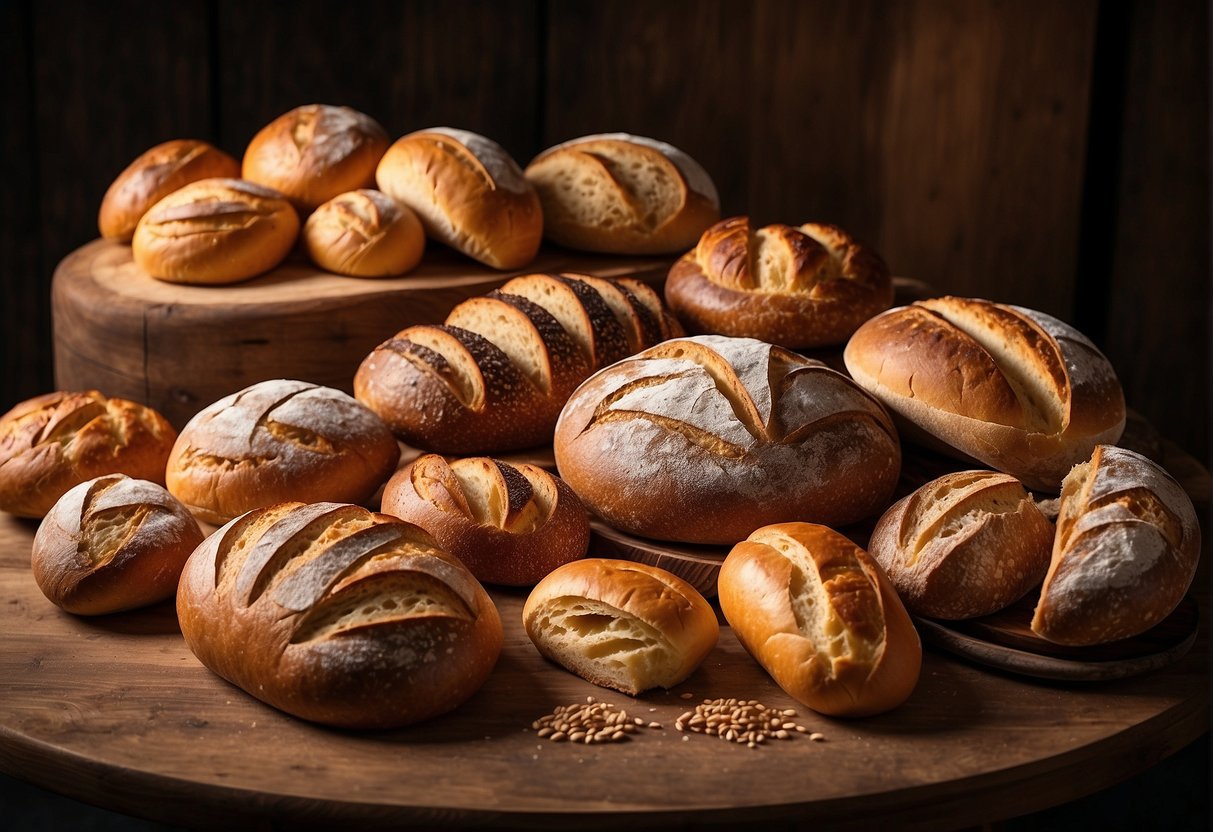
When deciding between artisan bread and sourdough, your taste preferences and health goals play a significant role. Assess how each type of bread aligns with your lifestyle and dietary needs to make an informed choice.
Balancing Taste and Health Preferences
Your personal taste preference is key when choosing bread. Sourdough has a distinct tangy flavor due to the lactic acid bacteria involved in its fermentation process. This not only contributes to its unique taste but also offers potential health benefits, as these bacteria can aid in digestion. On the other hand, artisan breads come in a wide range of flavors and textures, often made with varying combinations of whole grain, organic flours, and can include seeds or nuts for added taste and nutrition.
| Bread Type | Taste Note | Health Aspect |
|---|---|---|
| Sourdough | Tangy, strong flavor | May contain beneficial bacteria |
| Artisan Bread | Varies (nutty, seeds, grains) | Potential for whole grain, organic ingredients |
If health is a top concern, consider breads that are free from additives and preservatives, often found in mass-produced loaves. Look for options made with whole grain flour, which provide more fiber and nutrients. Should you prefer or require a gluten-free diet, some artisan breads may cater to this need, although traditional sourdough typically contains gluten.
Considering Lifestyle and Dietary Needs
Your lifestyle and dietary restrictions are just as important as taste. For a busy lifestyle, you might prefer bread that stays fresh longer, which may lead to choices that contain preservatives. However, if you’re inclined towards a more health-conscious, minimal-additive diet, both artisan and sourdough breads are excellent, as they are often made without unnecessary additives.
- For Active Lifestyles: Choose breads with higher protein and fiber, like those made with whole grain flour.
- For Organic Preferences: Look for artisanal loaves made with organic flour.
- For Dietary Restrictions: Sourdough or artisan breads labeled as gluten-free cater to specific needs.
By considering these aspects, you can better choose a bread that fits your taste, contributes to your health and wellness, and complements your lifestyle.
Frequently Asked Questions
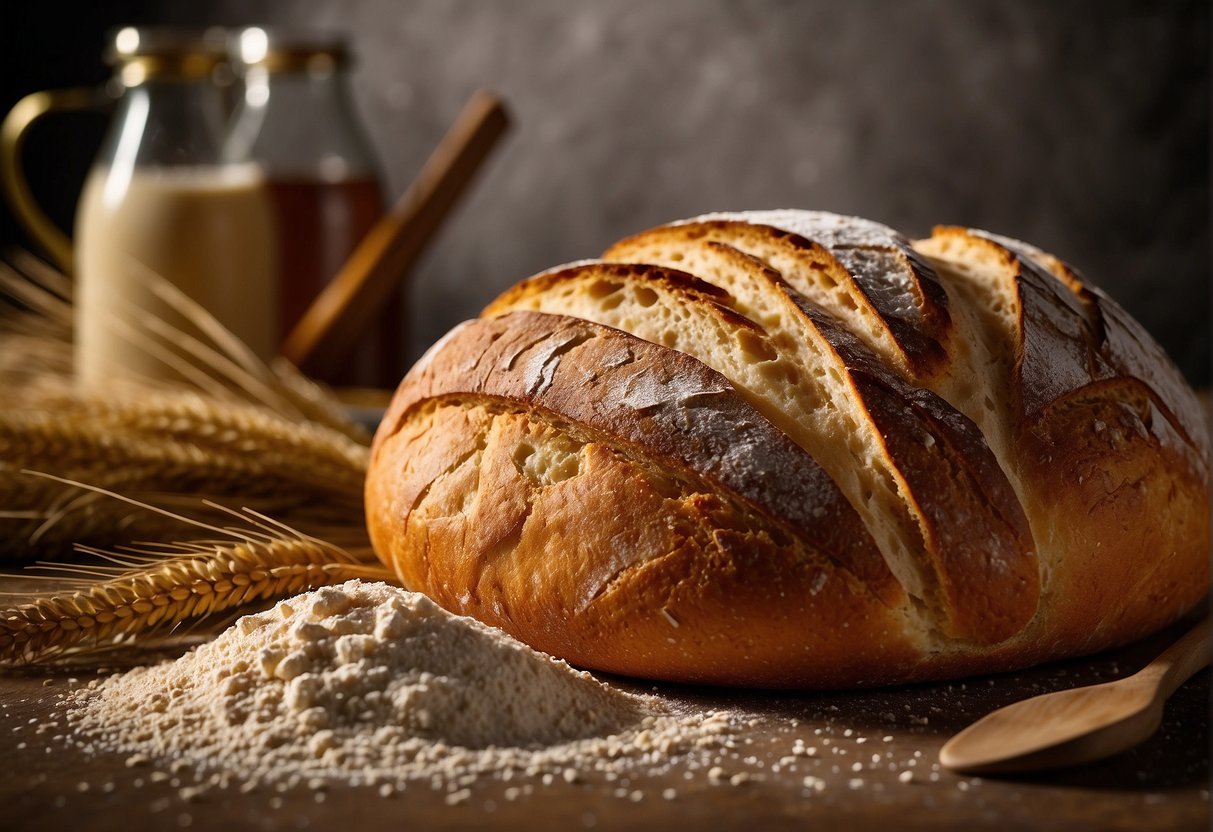
In this section, you’ll find answers to common queries exploring the distinctions and health benefits of artisan and sourdough breads, along with specific examples and characteristics.
What distinguishes artisan bread from regular bread?
Artisan bread is typically handcrafted in small batches without the use of artificial preservatives or mass-production methods, which sets it apart from regular, commercially produced bread.
In what ways is sourdough bread considered healthy?
Sourdough bread is known for being easier to digest, having a lower glycemic index, and containing natural probiotics due to the fermentation process involved in its making.
What are some examples of artisan bread?
Examples of artisan bread include baguettes, ciabatta, and focaccia, which are often recognized by their crisp crusts and soft, airy interiors.
What is the difference between sourdough and other types of bread?
The main difference lies in the leavening process; sourdough uses a naturally occurring starter for fermentation, while other breads typically use commercial yeast to rise.
How is artisan Italian bread characterized?
Artisan Italian bread, like ciabatta, is known for its rustic shape, chewy texture, and large, irregular air holes.
Can artisan bread be classified as white bread?
While some artisan breads do use white flour, artisan bread can encompass a range of different flours and grains, not limited to white bread alone.
